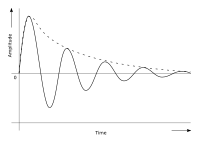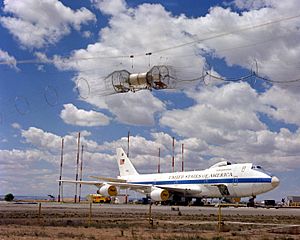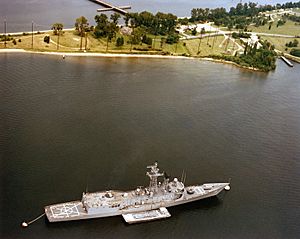Electromagnetic pulse facts for kids
An electromagnetic pulse (EMP) is a quick burst of electromagnetic energy. You can also call it a "transient electromagnetic disturbance." This energy burst can happen naturally or be made by humans. It can show up as an electromagnetic field, an electric field, a magnetic field, or as an electric current flowing through something.
When an EMP happens, it can mess up communications. It can also damage electronic equipment. For example, a lightning strike is a type of EMP. It can even physically harm things like buildings and airplanes. Learning how to handle EMP effects is part of electromagnetic compatibility (EMC) engineering.
The first time people recorded damage from an EMP was during a huge solar storm in August 1859. This event is known as the Carrington Event. In modern fighting, special weapons can create strong EMPs. These weapons are designed to stop communication devices. They can also disable computers in warplanes. Sometimes, they can even shut down a whole country's electrical grid.
Contents
What is an Electromagnetic Pulse?
An electromagnetic pulse is a very short burst of electromagnetic energy. Because it's so short, its energy spreads across many different frequencies. We usually describe pulses by a few key things:
- How the energy moves (like a wave, electric, magnetic, or through wires).
- The range of frequencyes it contains.
- The pulse's shape, how long it lasts, and how strong it is.
The range of frequencies and the pulse's shape are connected. This connection is explained by something called the Fourier transform. It shows how different waves combine to make the pulse we see.
How EMP Energy Moves
EMP energy can travel in four main ways:
- As an Electric field.
- As a Magnetic field.
- As Electromagnetic radiation (like radio waves).
- Through Electrical conduction (like electricity in a wire).
According to Maxwell's equations, an electric energy pulse always comes with a magnetic energy pulse. In most pulses, one of these forms will be stronger than the other. Usually, radiation travels long distances. Electric and magnetic fields mostly act over short distances. But there are some exceptions, like a solar magnetic flare.
EMP Frequency Ranges
An electromagnetic energy pulse usually contains many frequencies. These range from very low to a certain upper limit. This limit depends on where the pulse comes from. The range we call EMP usually doesn't include very high frequencies. These include infrared, visible light, ultraviolet light, and ionizing radiation like X-rays and gamma rays.
Some EMP events, like lightning or sparks, can create light. But this light is a side effect of the electricity flowing through the air. It is not part of the EMP itself.
Shapes of EMP Pulses
The "waveform" of a pulse shows how its strength changes over time. Real pulses can be quite complex. So, scientists often use simpler models. These models are usually shown in a diagram or as a math equation.
 Rectangular pulse |
 Double exponential pulse |
 Damped sinewave pulse |
Most electromagnetic pulses start very sharply. They quickly reach their strongest point. A common model is a "double-exponential curve." It climbs fast, peaks quickly, and then fades away more slowly. However, pulses from controlled electrical circuits often look like a rectangular or "square" pulse.
EMP events often create a signal in the things around them. This connection usually happens best over a narrow range of frequencies. This creates a special kind of wave called a damped sine wave. It looks like a fast sine wave that grows and shrinks inside the longer-lasting double-exponential curve. A damped sine wave usually has less energy. It also has a narrower frequency spread than the original pulse. This is because of how the energy transfers. When testing for EMP, equipment often creates these damped sine waves directly. This is easier than trying to make the high-energy threat pulses.
In a series of pulses, like from a digital clock, the wave shape repeats regularly. Just one full pulse cycle is enough to describe such a regular, repeating series.
Different Kinds of EMP
An EMP happens when a source sends out a short burst of energy. This energy is usually spread across many frequencies. However, it often causes a specific, narrow-band damped sine wave response in the environment. Some types of EMP are created as regular, repeating pulse trains.
EMP events can come from natural sources, human activities, or weapons.
Natural EMP Events
Natural EMP events include:
- Lightning electromagnetic pulse (LEMP). A lightning strike usually starts with a low-energy "leader" discharge. Then comes the main, powerful pulse. After that, several smaller bursts of energy may follow.
- Electrostatic discharge (ESD). This happens when two charged objects get close or touch. Think of getting a shock from a doorknob.
- Meteoric EMP. This is an electromagnetic energy burst. It happens when a meteoroid hits a spacecraft. Or when a meteoroid breaks apart explosively in Earth's atmosphere.
- Coronal mass ejection (CME). Sometimes called a solar EMP. This is a burst of plasma and a magnetic field. It shoots out from the Sun's outer atmosphere (the corona) into the solar wind.
Man-Made EMP Events
Everyday man-made EMP events include:
- When electrical circuits are switched on or off. This can be a single event or a repeating series of pulses.
- Electric motors can create a series of pulses. This happens as their internal electrical parts connect and disconnect while the motor spins.
- Gasoline engine ignition systems can make a series of pulses. This occurs when the spark plugs are powered or fired.
- The constant switching of digital electronic circuits.
- Power line surges. These can be very strong, sometimes thousands of volts. They are powerful enough to damage electronic equipment that isn't protected.
Military EMP Events
Military EMPs are created by weapons:
- Nuclear electromagnetic pulse (NEMP). This is a sudden pulse of electromagnetic radiation from a nuclear explosion. The fast-changing electric fields and magnetic fields can connect with electrical systems. This creates damaging current and voltage surges.
- Non-nuclear electromagnetic pulse (NNEMP) weapons.
Nuclear EMP (NEMP)
A nuclear electromagnetic pulse is a sudden burst of electromagnetic radiation. It comes from a nuclear explosion. The quickly changing electric fields and magnetic fields can connect with electrical systems. This creates damaging current and voltage surges.
The strong gamma radiation released can also turn the surrounding air into charged particles. This creates a second EMP. This happens as air atoms first lose their electrons and then get them back.
NEMP weapons are made to create the biggest EMP effects. These effects are their main way of causing damage. Some NEMP weapons can destroy sensitive electronic equipment over a large area.
A high-altitude electromagnetic pulse (HEMP) weapon is a NEMP warhead. It is designed to explode high above Earth's surface. The explosion sends out a blast of gamma rays into the middle stratosphere. This causes the air to become charged particles. These charged particles then interact with Earth's magnetic field. This creates a much stronger EMP than what happens in denser air closer to the ground.
Non-Nuclear EMP (NNEMP)
Non-nuclear electromagnetic pulse (NNEMP) is an EMP created by a weapon without using nuclear technology. Devices that can do this include:
- A large bank of capacitors that quickly release their energy into a special antenna.
- A microwave generator.
- An explosively pumped flux compression generator.
To make the pulse's frequency right for affecting a target, special circuits or microwave generators are used. These are placed between the pulse source and the antenna. Vircators are special vacuum tubes. They are very good at turning high-energy pulses into microwaves.
NNEMP generators can be carried by bombs, cruise missiles (like the CHAMP missile), and drones. They cause less mechanical damage, heat, and radiation. Plus, they don't have the serious consequences of using nuclear weapons.
The range of NNEMP weapons is much smaller than nuclear EMPs. Almost all NNEMP weapons use chemical explosives as their first energy source. They produce only a tiny fraction of the energy of nuclear explosives of similar weight. The EMP from NNEMP weapons must come from inside the weapon itself. Nuclear weapons create EMP as a side effect. These facts limit the range of NNEMP weapons. But they also allow for more precise targeting. Small "e-bombs" have been effective for certain military operations. For example, they can destroy electronic control systems in many ground vehicles and aircraft.
The idea of using an explosively pumped flux compression generator for NNEMP was thought of as early as 1951. This was by Andrei Sakharov in the Soviet Union. But countries kept their work on non-nuclear EMP secret until similar ideas appeared in other nations.
What EMP Does
Small EMP events, especially repeating pulses, cause low levels of electrical noise. This noise can affect how sensitive devices work. For example, in the mid-1900s, a common problem was interference from gasoline engine ignition systems. This made radios crackle and TVs show stripes. Laws were made to make car makers add special devices to stop this interference.
At a high voltage level, an EMP can create a spark. For instance, an electrostatic discharge can cause a spark when fueling a gasoline car. Such sparks have been known to cause fuel-air explosions. So, people must take steps to prevent them.
A large and strong EMP can create high currents and voltages in electronic devices. This can temporarily stop them from working. Or it can even damage them permanently.
A very powerful EMP can also directly affect magnetic materials. It can corrupt data stored on things like magnetic tape and computer hard drives. Hard drives are usually protected by strong metal cases. Some companies that get rid of old computer equipment use a controlled EMP. This helps them erase data from magnetic storage devices.
A very large EMP event, like a lightning strike or a nuclear weapon exploded in the air, can also directly damage objects. This includes trees, buildings, and aircraft. This damage can happen from heating effects. Or it can be from the strong magnetic field created by the current. An indirect effect can be electrical fires caused by overheating. Most engineered buildings and systems need some protection against lightning. A good way to protect things is with a Faraday cage. This shield helps keep certain items safe from damage.
How to Control EMP Effects
Like any electromagnetic interference, the danger from EMP can be managed. This is true whether the threat is natural or man-made. Most control methods focus on how easily equipment is affected by EMP. They aim to make it stronger or protect it from harm. Man-made sources, other than weapons, are also controlled. This is to limit the amount of pulse energy they release.
The field that makes sure equipment works correctly when EMP and other radio frequency threats are present is called electromagnetic compatibility (EMC).
Testing EMP Effects
To test how EMP affects engineered systems and equipment, an EMP simulator can be used.
Simulating Induced Pulses
Induced pulses have much less energy than real threat pulses. So, they are easier to create. But they are also less predictable. A common test method uses a current clamp in reverse. It injects different damped sine wave signals into a cable connected to the equipment being tested. The damped sine wave generator can create the range of signals that are likely to happen.
Simulating Threat Pulses
Sometimes, the actual threat pulse itself is simulated in a way that can be repeated. The pulse can be made at low energy. This helps to understand how the equipment responds before injecting damped sine waves. Or it can be made at high energy to copy the real threat conditions. A small ESD simulator can be held in your hand. Larger simulators, for a bench or a room, come in different designs. These depend on the type and strength of the threat to be created.
At the highest level, large outdoor test facilities have been built by several countries. These facilities have high-energy EMP simulators. The biggest ones can test entire vehicles, including ships and aircraft. They check how easily these vehicles are affected by EMP. Almost all of these large EMP simulators use a special version of a Marx generator. One example is the huge wooden ATLAS-I simulator (also known as TRESTLE). It was located at Sandia National Labs in New Mexico. At one point, it was the world's largest EMP simulator. The US Navy also has a large facility called the Electro Magnetic Pulse Radiation Environmental Simulator for Ships I (EMPRESS I).
Safety with EMP
Strong EMP signals can be dangerous to human safety. In such situations, you should avoid touching a live electrical wire. If you do touch something highly charged, like a Van de Graaff generator, be careful. You should release the object. Then, let your body discharge slowly through something with high resistance. This helps avoid a harmful shock when you step away.
Very strong electric fields can cause the air to break down. This can create a deadly electric arc, similar to lightning. However, electric field strengths up to 200 kV/m are generally considered safe.
According to research from Edd Gent, a 2019 report was made by the Electric Power Research Institute. This group is funded by utility companies. The report found that a large EMP attack would likely cause regional blackouts. But it would probably not cause a nationwide power grid failure. The time it would take to get power back would be similar to other large-scale outages. It is not known how long these blackouts would last. Or how much damage would happen across the country. Neighboring countries of the U.S. could also be affected. This depends on the target area and people.
According to an article by Naureen Malik, North Korea has been testing missiles and warheads more successfully. Because of this, the U.S. Congress decided to restart funding for a special group. This group is called the Commission to Assess the Threat to the U.S. from Electromagnetic Pulse Attack. This was part of the National Defense Authorization Act. Right now, the United States is not fully ready for an EMP attack.
According to research from Yoshida Reiji, in a 2016 article, Onizuka warned about a high-altitude EMP attack. He said it would damage or destroy Japan's power, communications, and transport systems. It would also disable banks, hospitals, and nuclear power plants.
See also
 In Spanish: Pulso electromagnético para niños
In Spanish: Pulso electromagnético para niños
- Directed-energy weapon
- Electromagnetic compatibility
- Electromagnetic environment
- Electronic warfare
- Faraday's law of induction
- Geomagnetic storm
- MIL-STD-461, a United States Military Standard that describes how to test equipment for electromagnetic compatibility
- Pulsed power
- Transient (oscillation)
- Ultrashort pulse



